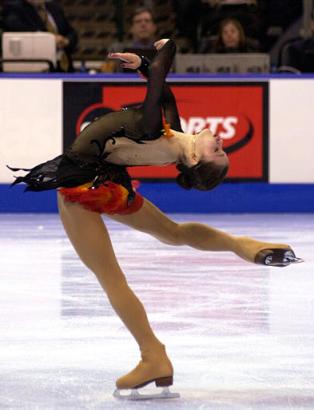
Prior to the nineties, figure-skating competitions included a segment known as compulsory figures, in which the skater traced a set pattern on the ice, or the figure eight. Competitors had to skate the figures using a prescribed part of the blade, which included change of edge, steps and turns that were performed at specific points on the skating surface. Compulsory figures trained skaters to be faster, more quick-feet, and allowed them the ability to flow on the ice as well.
School of figures was the very foundation of skating. Figure Skating was named for the art form which involved creating intricate patterns on the ice with the edges of the blades. As a result, compulsory figures became a must for training and competitions. Compulsory figures were based on the figure eight and its variations. Skaters traced identical patterns on the ice three times and were judged on their ability to replicate the exact figures in the same place. They made circles on the ice with one foot, then retrace those circles with the other foot. The circles are the actual figures from which the term figure skating is stemmed.
The completed tracings left by the skater's blades were evaluated by judges. Judges would study and grade the patterns. Points were deducted if the skater skated outside of the line; or if there were additional tracings or wobbling. These intricate patterns into the ice, were designed to assure the judges that the skaters had mastered the fundamentals of their sport.
Skaters spend hours skating patches- Patch practice sessions were usually one-hour in length. Most skaters usually practiced at least two hours of patch time per day. These patches of ice were completely clean pieces of ice with not a mark or skid on them. The skater’s objective was to trace perfect circles on these clean pieces of ice
Figures allow them to learn edge control, good posture, and balance. Ideally, edges were supposed to be clean without scratches, undesired changes of an edge, or without evidence of no edge tracing. Now figures are no longer part of elite competition. With these changes, the emphasis in the free skate shifted to an increase in athleticism or a jumping contest.
Up until 1990, compulsory figures were part of the singles figure skating competition. Skaters had to execute figures which were then measured by judges. According to the review of literature, the judges sometimes used the school figures as a means of marking up or marking down skaters. The figures were also used by some judges as a basis for down grading newer skaters. Typically, a skater in his/her first appearance at an international competition would not expect high marks in the school figures, even if he or she might have felt that they had skated solid figures.
Even after the school figures were reduced from sixty percent to thirty percent of the overall score, with the new short program weighing twenty percent and the long program fifty percent by the 1980s, skaters who built a vast lead in figures had a strong chance of winning the competition. Figures still had a great impact on the final outcome.
The omission of compulsory has also taken a toll on the sport; compulsory figures are needed to teach skaters basic skills. Abolishing the compulsories has resulted skating into jumping contests and in turn may cause more injuries. Skating is about control, centering and balance. Those are the things school of figures brought. Now that we don't have school of figures, skaters are turning to ice dance instructors to teach them what they need to maintain speed and flow on the ice.
Compulsory is different from free skating. It is very difficult and has kept many skaters from the top of the podium. Many competitors feel that compulsories have no place in modern skating; they think it to be tedious, and boring to watch. Denise Bielman, like many skaters, did not like to practice figures. She preferred the free skate which gave her the freedom to bounce spin and dance to the music.
Now that figures are a thing of the past, skaters are flocking to dance instructors to teach them what they need to do to maintain speed, and flow on the ice. The omission of figures has impacted the art in the sport as well. Figures gave skaters the foundation they needed to balance, control, and command the ice. A skater cannot be an artist if those skills are lacked. This quality of skating is paramount to the art of skating. In the end, the sport will remain a jumping contest among prepubescent teens. The compulsories give students the quality of edges, technique, and control they need.






